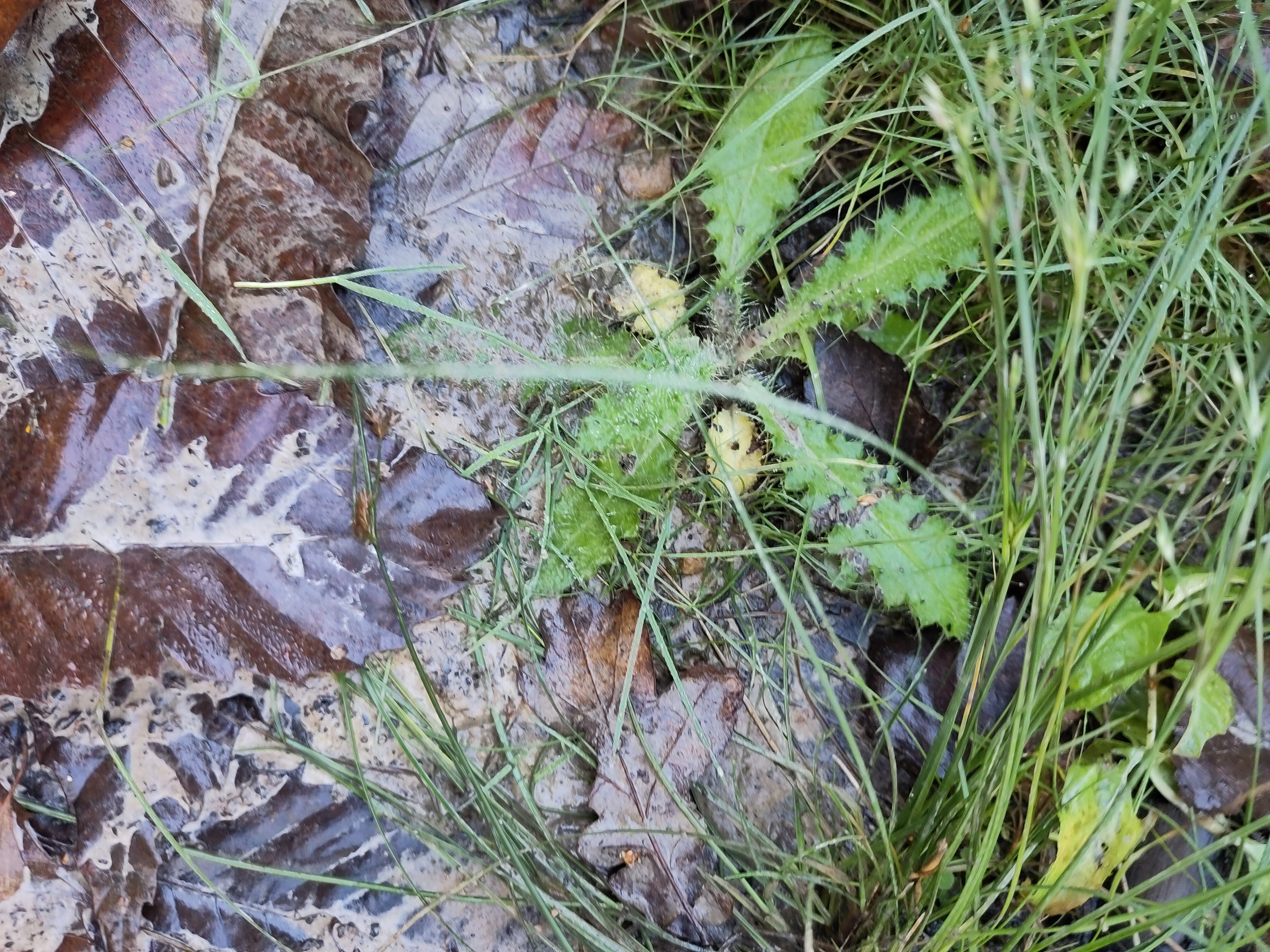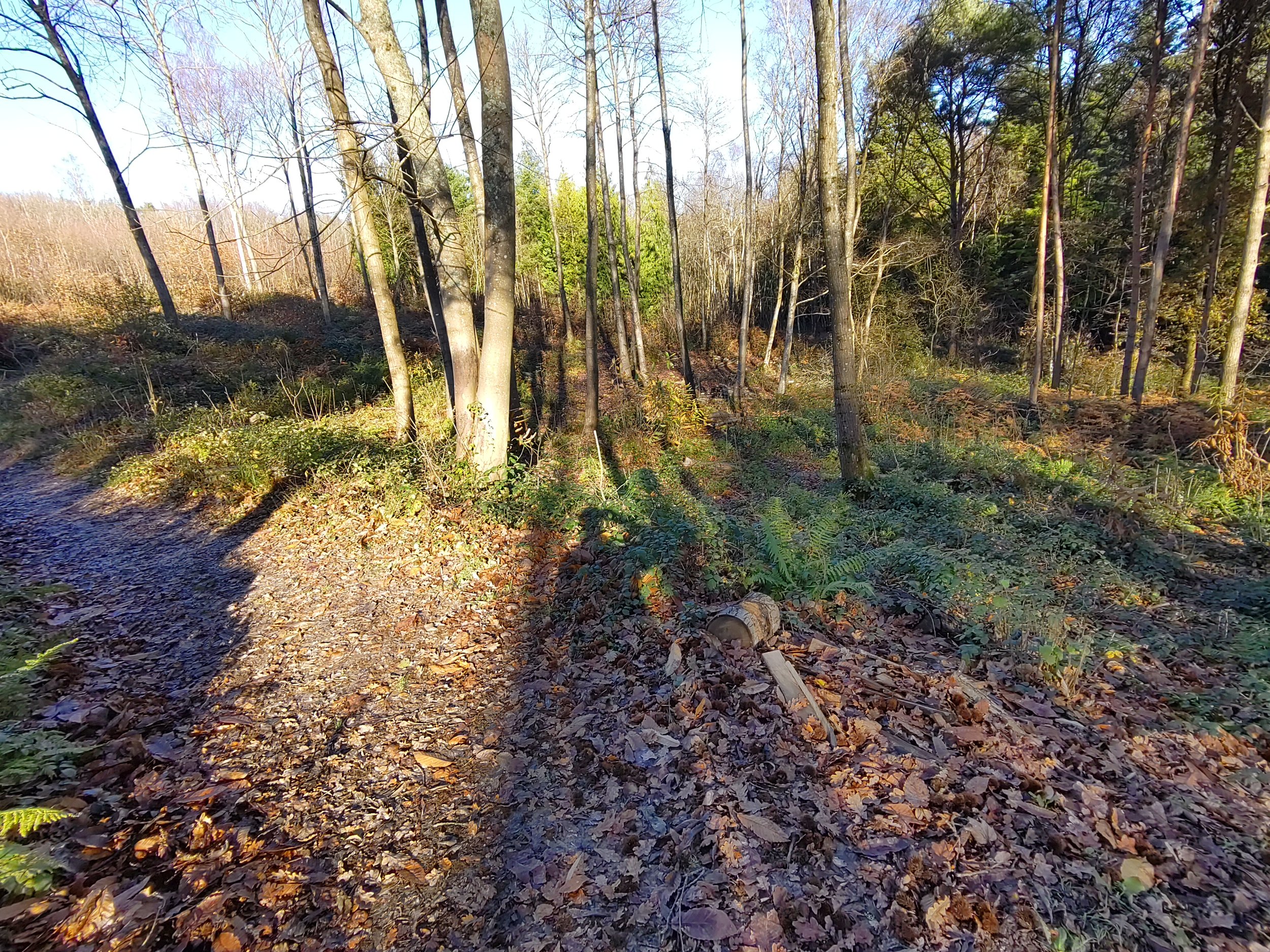An Ecological Survey of Steep Hill
The straight, steep and badly eroded track at Steep Hill
28th November 2023
It is a crisp, far from warm November morning and I am glad. Had it been wet life would be much more difficult.
I've been asked to do an ecological survey for the proposed improvements for Steep Hill access. This will involve lots of standing still and writing, so the cold could be an issue, but writing notes in the rain is far more problematic. Thankfully the skies are pretty clear, so there is plenty of sun, although at this time of year warmth is relative. The least bit of shadow from a tree and my thermometer drops several degrees. The top of steep hill is where I start my survey and is dominated by 2 year old coppice, meaning an absence of tall trees, other than the odd oak standard. So perhaps there will be less shade/cold.
I decide to measure the slope angle of the top of the hill - 1.8m fall over 15m . I'm not certain why I'm measuring gradient, but it's a good 'limbering-up' exercise. I always think it's good to start collecting more data than you probably need and then cut it back once you get an idea of the scale and the needs of the project. You can't add data quite so easily.
I use an app on my phone called Bubble. It seems to work ok and I get a result, but I'm now lulled into false sense of security. A little further downhill I opt to repeat the exercise and turn on the app.
Immediately a loud thirty-something female leaps out of the screen at me to sell me a dating site. I nearly drop the phone, and of course the young lady with it. I'm not dating today thank you! So I swipe her off and uninstall the app. The last thing you expect on a levelling app is to be mugged by a member of the opposite sex half your years!
Now that I'm alone again I can continue with my survey - I'll bring a clinometer next time! In fact I've gone right off gradients now.
I have with me the luxury of a species list, compiled for Wilderness Wood 4 years ago by a group of keen naturalist. This is fortunate since it provides me with a crutch to lean on. So much simpler if you have a second opinion regarding what species are on site. As it turns out, most of the things I do find are quite common - bramble, bracken, oak, holly, beech. The familiar things are easy to record, as are plants that are very distinctive and look like no other. The tough ones are things like yellow 'dandelion-like' flowers, thistles or members of the willowherb family, many of which look near identical at this time of year.
A thistle, but which species - identifying plants in November is not an easy task
I work my way down the main track of Steep Hill, the one used by our quad bike or horses when extracting timber. Checking from side to side I quickly realise bracken and bramble crowd-out almost everything else that is smaller than them. The most diverse bits are the edges of the path where light is available for the smaller things. Nothing lives in the path itself due to lots of surface runoff removing any vestige of soil.
At the bottom of Steep Hill I feel I have the measure of the site in terms of its geographic extent. So I return uphill by the alternative pedestrian route created by Chris Yarrow, the previous owner of the wood. This is a little gentler, except where steps have been put in place. These alas have been badly eroded by running water. Neither this nor the main track is suitable, so a brand new path is required for pedestrian access. We are hoping to attract funding from 'The Farming in Protected Landscapes programme' - part of Defra’s Agricultural Transition Plan. Hence the need for an ecological survey.
Plans for Steep Hill’s upgrade to a pedestrian-friendly access
On the return trip I tick-off several more species of plants, including trees, flowering plants, ferns, fungi (strictly speaking not plants at all) and mosses. I also add a code next to each species found to denote how often it occurs (ACFOR Scale – Abundant, Common, Frequent, Occasional and Rare). This completed, I'm starting to feel a bit warmer from the exercise and the increased elevation of the morning sun. I can think of far worse things to do on a sunny day in November!
To get a full picture of what is here I range a little further up the hill and along an adjacent track to record anything else within the area which could provide a source of seed. Likewise I look out for animal life. November is not the best time of year to do an ecological survey since not an insect stirs and not even a bird. However, I do disturb a wood mouse, which hops through the undergrowth at a blinding speed. Grey squirrels are always visible and the mole leaves tell-tale piles of soil everywhere. Likewise deer will leave hoof prints.
Wide-angle view of the vegetation surrounding Steep Hill
After 2 hours of wandering around I am satisfied that I have noted most things likely to grow here. Even spring flowers leave traces behind eg. Bluebell seed heads and the leaves of wood sorrel. Others however are a bit trickier eg. Wood anemone, orchids and of course warm loving animals such as reptiles, some mammals and migratory birds.
All I have to do now is write-up my report and make a few recommendations. It is evident that changes to the path will not have a major impact upon the wildlife of Wilderness Wood. The acidic nature of the soil, the past management of the site and the pressure from visitor numbers all conspire to reduce our biodiversity. But this is part of the attraction of volunteering for Wilderness Wood - to take a site with limited biodiversity and enhance it. Once rerouted, the area either side of the path at Steep Hill will be managed as a woodland glade habitat. Woodland edge species will inevitably increase due to letting more light enter. Some of the species which may benefit include spindle, buckthorn, alder buckthorn, wayfaring tree, guelder rose - all seed/fruit-bearing shrubs which will provide food for birds.
The new path will be more winding, thereby reducing the surface run-off currently endured by then current straight track which is now so badly eroded. Retention of soil will mean cushion-forming plants will grow on the path eg. hawkbeards, speedwell, plantains. Hopefully Defra will be happy with the results and we will be able to start work on the changes to Steep Hill shortly.
By 12.20 I am positively baking and just about ready to head back to The Barn for lunch. AS I return I catch sight of my first bird, a blue-tit swinging upsidedown in a blackthorn shrub. He’s certainly going to be a winner if we can encourage more fruiting shrubs.
Follow my expeditions on foot and by bike around the UK coast at www.leggingroundbritain.com




